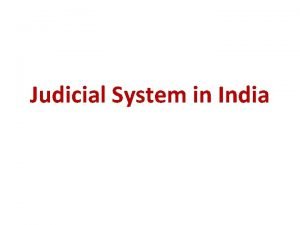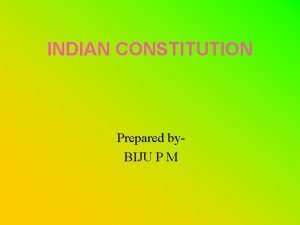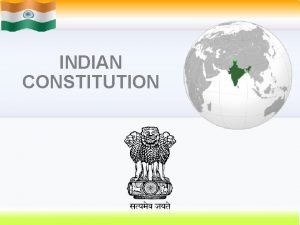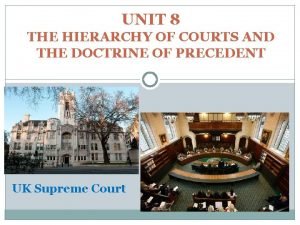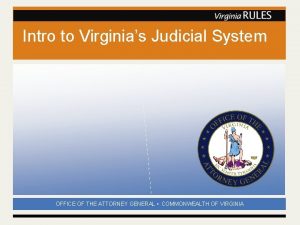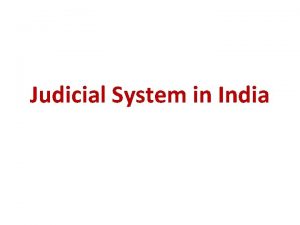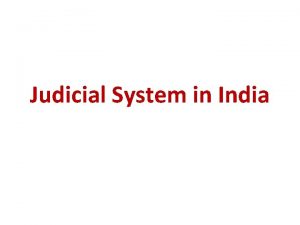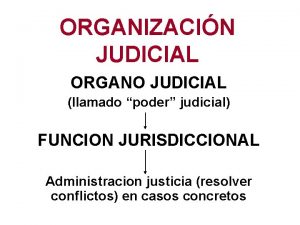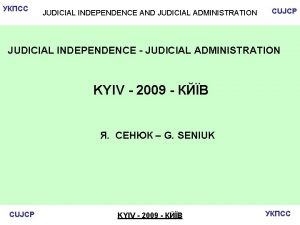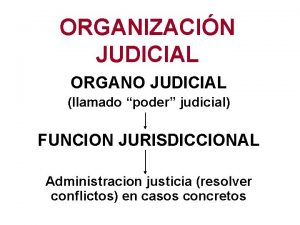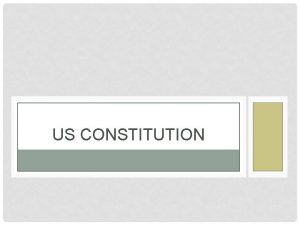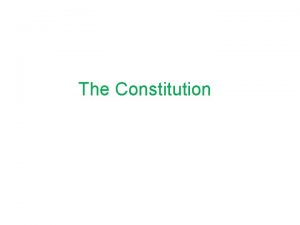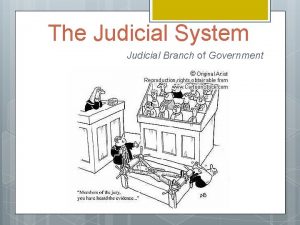Judicial System in India Introduction The Constitution of





















- Slides: 21

Judicial System in India

Introduction • The Constitution of India provides for a single integrated judicial system with the Supreme Court at the apex, High Courts at the middle (state) level and District Courts at the local level. • It also provides for an independent and powerful judicial system. • Judiciary in India acts as the guardian protector of the Constitution and the fundamental rights of the people.


Hierarchy of Judiciary in India

Functions of Judiciary


The Supreme Court • The Supreme Court has – original, – Appellate, – writ and – Advisory Jurisdictions

Jurisdiction of High Court • Every High Court enjoys original jurisdiction with respect to revenue and its collection, cases of succession, divorce etc. • In its appellate Jurisdiction, it hears appeals from the lower courts in cases concerning sales-tax, income tax, copy right, patent-right etc. The High Court is a court of record and its proceedings and decisions are referred to in future cases. • A High court can issue writs for the enforcement of fundamental rights or for any other such purpose. • A High Court supervises the working of all subordinate courts and frames rules and regulations for the transaction of business. • The High Court is empowered to interpret the constitution of India. It can review the laws of the State Legislature and may declare them null and void if they go against the provisions of the constitution. • Again, if a High court is satisfied that a case pending in a lower court involves a substantial question of law as to the interpretation of the constitution, it my dispose of the case itself.

Subordinate courts • There are subordinate courts below the High court in each state. • The courts are under the complete control of the High court. The lower court (e. g. Nyaya Panchayat or Munsiffs court) deals with minor cases while the higher courts (e. g. , subordinate Judge’s court or District Judge’s court) deal with important cases. • Appeals lie to the higher courts from the lower courts. An appeal may also lie to the High Court against the decisions of the District judge’s court or the Session Judge’s court. • In a Presidency town, there are city civil courts and Metropolitan Magistrates courts. • In this connection, we are to note that most of the Judges of the subordinate courts are appointed by the Governor in consultation with the High Court of the concerned State.

Salient Features of Indian Judiciary

1. Single and Integrated Judicial System • The Constitution establishes a single integrated judicial system for the whole of India. • The Supreme Court of India is the highest court of the country and below it are the High Courts at the state level. • Other courts (Subordinate Courts) work under the High Courts. • The Supreme Court controls and runs the judicial administration of India. • All courts in India form links of a single judicial system.

2. Independence of Judiciary: The Constitution of India makes judiciary truly independent. It provides for: (i) Appointment of judges by the President, (ii) High qualifications for appointment as judges, (iii) Removal of judges by a difficult method of impeachment, (iv) High salaries, pension and other service benefits for judges, • (v) Independent establishment for the Judiciary, and • (vi) Adequate powers and functional autonomy for the Judiciary. • • All these features together make the Indian Judiciary an independent judiciary.

3. Judiciary as the Interpreter of the Constitution • The Constitution of India is a written and enacted constitution. • The right to interpret and clarify the Constitution has been given to the Supreme Court. • It is the final interpreter of the provisions of the Constitution of India.

4. Judicial Review • The Constitution of India is the supreme law of the land. • The Supreme Court acts as the interpreter and protector of the Constitution. • It is the guardian of the fundamental rights and freedoms of the people. • For performing this role, it exercises the power of judicial review. • The Supreme Court has the power to determine the constitutional validity of all laws. • It can reject any such law which is held to be unconstitutional. High Courts also exercise this power.

5. High Court for each states as well a Provision for Joint High Courts • The Constitution lays down that there is to be a High Court for each state. • However, two or more states can, by mutual consent, have a Joint High Court.

6. Supreme Court as the Arbiter of legal disputes between the Union and States The Constitution gives to the Supreme Court the jurisdiction in all cases of disputes: • (i) Between the Government of India and one or more states, • (ii) Between the Government of India and any state or states on one side and one or more states on the other, and • (iii) Between two or more states.

7. Guardian of Fundamental Rights • Indian judiciary acts as the guardian of fundamental rights and freedoms of the people. • The people have the Right to Constitutional Remedies under which they can seek the protection of the courts for preventing a violation or for meeting any threat to their rights. • The Supreme Court and the High Courts have the power to issue writs for this purpose.

8. Separation of Judiciary from the Executive • The Constitution of India provides for a separation between the judiciary and the other two organs of the government. • The judiciary is neither a branch of the executive nor in any way subordinate to it. • The judicial administration in India is oraganised and run in accordance with the rules and orders of the Supreme Court.

9. Open Trial • The courts in India are free. • These conduct open trials. • The accused is always given full opportunity to defend himself. • The state provides free legal aid to the poor and needy.

10. Judicial Activism • Indian Judicial System has been becoming more and more active. • The Supreme Court has been coming out with judicial decisions and directives aimed at active protection of public interest and human rights. • Judiciary has been giving directives to public officials for ensuring a better security for the rights of the public. • The Public Interest Litigation system has been picking up. The system of Lok Adalats has also taken a proper shape and health.

11. Public Interest Litigation System • Under this system the courts of law in India can initiate and enforce action for securing any significant public or general interest which is being adversely affected or is likely to be so by the action of any agency, public or private. Under it any citizen or a group or a voluntary organisation, or even a court herself, can bring to notice any case demanding action for protecting and satisfying a public interest. • It provides for an easy, simple, speedier and less expensive system of providing judicial relief to the aggrieved public. With all these features, the Indian Judicial System is an independent, impartial, free, powerful and efficient judicial system.
 Judicial activism vs judicial restraint
Judicial activism vs judicial restraint Judicial activism vs restraint
Judicial activism vs restraint Judicial activism vs judicial restraint
Judicial activism vs judicial restraint Judicial restraint vs judicial activism
Judicial restraint vs judicial activism Judicial restraint
Judicial restraint Texas constitution vs us constitution
Texas constitution vs us constitution Nc constitution vs us constitution
Nc constitution vs us constitution Constitution what is constitution
Constitution what is constitution The constitution lesson 1 principles of the constitution
The constitution lesson 1 principles of the constitution 3 types of courts in india
3 types of courts in india Importance of constitution of india
Importance of constitution of india What is constitution anyway
What is constitution anyway England hierarchy
England hierarchy Virginia judicial system
Virginia judicial system Hát kết hợp bộ gõ cơ thể
Hát kết hợp bộ gõ cơ thể Frameset trong html5
Frameset trong html5 Bổ thể
Bổ thể Tỉ lệ cơ thể trẻ em
Tỉ lệ cơ thể trẻ em Chó sói
Chó sói Thang điểm glasgow
Thang điểm glasgow Hát lên người ơi
Hát lên người ơi Các môn thể thao bắt đầu bằng tiếng nhảy
Các môn thể thao bắt đầu bằng tiếng nhảy









